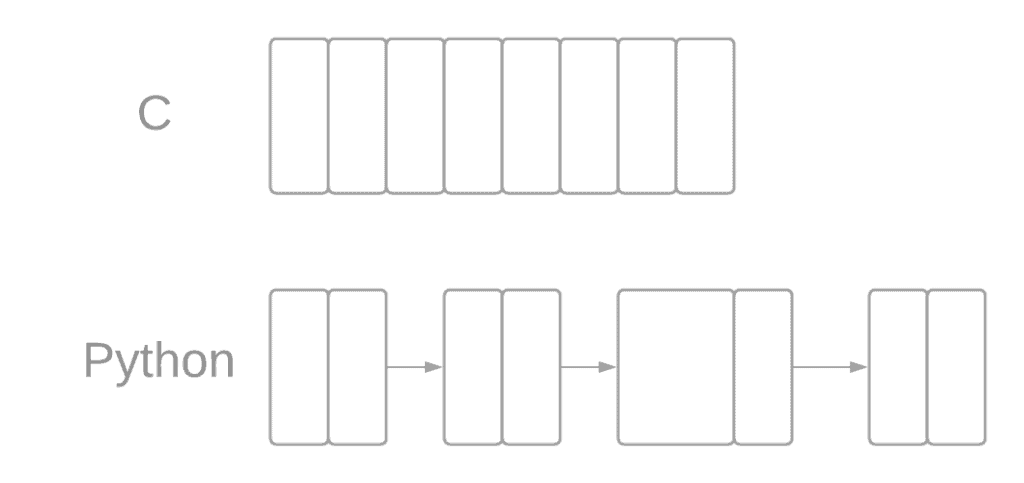1. 简介
在计算机科学中,数据结构与算法是编程的核心概念之一。它们在程序中扮演着操作数据的关键角色,因此理解这些概念对掌握编程至关重要。
要学习和实现这些思想,我们可以选择多种不同的编程语言。每种语言都能完成基本任务,但各有其特点。为了选择最适合我们需求的工具,本文将介绍数据结构的基本思想,并比较几种主流编程语言在实现这些结构时的差异。
2. 概述
数据结构是一种以数学方式组织计算机内存空间的方法,使得数据可以被高效访问。 因此,数据结构通常与算法一起讨论,因为结构的创建和销毁都需要通过算法来完成。我们通常会实现一些基础操作,主要包括:
- 插入
- 删除
- 查找元素
为了完成这些任务,我们通常会使用指针和动态内存分配来管理内存。在面向对象编程中,内存管理通常通过类的构造函数和析构函数来实现。这种在不再需要时自动释放内存的机制称为垃圾回收(Garbage Collection)。
理想情况下,我们希望算法尽可能高效,只修改完成任务所需的最小部分。算法的效率可以通过时间复杂度和空间复杂度进行分析。
3. 单向链表
不同编程语言在实现数据结构时各有优势与限制。我们将通过实现一个包含3个节点的简单单向链表,来展示几种主流语言之间的差异。 链表由节点组成,每个节点包含数据和指向下一个节点的指针。
我们将只展示结构的构建过程,不涉及插入、删除、获取链表长度等完整功能。
结构如下图所示:

3.1. C
C 是一种强类型语言,所有变量和对象类型都必须显式声明。 它常用于嵌入式系统、数据库和驱动开发。
由于 C 不是面向对象语言,我们使用结构体代替类。示例如下:
typedef struct node_t {
char * data;
struct node_t * next;
} node;
typedef struct SLinkedList {
node* head;
} linkedList;
然后连接节点:
node1->next = node2;
使用这些语句,我们可以构建一个链表,并让 head 指向第一个节点。
✅ 优点:适合从头学习实现机制
❌ 缺点:无自动垃圾回收,需手动释放内存
⚠️ 注意:字符串操作需引入标准库(如 string.h)
3.2. C++
C++ 是 C 的面向对象扩展,广泛用于操作系统、游戏开发和机器学习。它支持封装、继承、多态等特性。
我们可以使用类来封装节点和链表逻辑:
class Node {
public:
char * data;
Node* next;
Node() {
data = NULL;
next = NULL;
}
};
class SLinkedList {
public:
SLinkedList(Node* firstnode) {
head = firstnode;
}
private:
Node* head;
};
✅ 优点:构造函数和析构函数自动管理内存
⚠️ 注意:head 为私有成员,只能通过构造函数访问,增强了封装性
⚠️ 缺点:语法略复杂,仍需手动管理指针
3.3. Java
Java 是基于 C++ 的高级语言,语法相似,但内置了更多功能,无需引入外部库即可处理字符串等操作。
我们可以将 Node 嵌套在 SLinkedList 类中:
class SLinkedList {
class Node {
String data;
Node next;
Node(String d) {
data = d;
}
}
SLinkedList(Node start) {
head = start;
}
private Node head;
}
使用时:
SLinkedList mylist = new SLinkedList(new Node("First"));
✅ 优点:自动内存管理(GC),语法简洁
✅ 优点:跨平台支持良好,适合企业级开发
⚠️ 缺点:性能略低于 C/C++,不适合底层开发
3.4. Python
Python 是一种广泛用于机器学习、Web 应用等领域的高级语言。 它是动态类型语言,无需显式声明变量类型。
定义节点类:
class Node:
def __init__(self, dataval=None):
self.dataval = dataval
self.nextval = None
构建链表:
node1 = Node("First")
list1 = SLinkedList(node1)
连接节点:
node1.nextval = node2
✅ 优点:语法简洁,缩进定义结构,无需手动管理内存
✅ 优点:列表可直接模拟链表行为,一行代码即可实现:
positions = ["First", "Second", "Third"]
⚠️ 缺点:运行效率较低,不适合性能敏感场景
对比 C 和 Python 的数组实现:

3.5. JavaScript
JavaScript 主要用于 Web 开发,语法严谨程度介于 Python 与 Java 之间。
定义类:
class Node {
constructor(text) {
this.position = text;
this.next = null;
}
}
class LinkedList {
constructor(head = null) {
this.head = head;
}
}
创建节点:
let node1 = new Node("First");
✅ 优点:支持类和构造函数,适合前端开发
⚠️ 缺点:非强类型,运行时错误较多,需配合 TypeScript 使用
4. 总结
以上语言都能实现基础的数据结构操作。选择语言应根据具体场景:
| 场景 | 推荐语言 |
|---|---|
| 需要底层理解、嵌入式开发 | ✅ C |
| 机器学习 | ✅ C++ / Python |
| Web 开发 | ✅ JavaScript / Python |
| 游戏开发 | ✅ C++ / Java / Python |
| 快速原型开发、少坑 | ✅ Python |
以下是语言特性对比表:
| 语言 | 简洁性 | 垃圾回收 | 踩坑数 | 内存控制 | 对底层理解 |
|---|---|---|---|---|---|
| C | ❌ | ❌ | ✅✅✅ | ✅✅✅ | ✅✅✅ |
| C++ | ❌ | ⚠️(类中) | ✅✅ | ✅✅✅ | ✅✅ |
| Java | ⚠️ | ⚠️(类中) | ✅ | ✅✅ | ✅✅ |
| Python | ✅✅✅ | ✅✅✅ | ❌ | ❌ | ⚠️ |
| JavaScript | ⚠️ | ⚠️(类中) | ⚠️ | ✅✅ | ✅✅ |
5. 结语
本文没有涵盖所有语言,比如 Go 和 Swift,但它们的语法大多与 C 或 C++ 相似。掌握上述语言将为学习其他语言打下坚实基础。最重要的是:选择一门语言,动手写代码,开始实践!